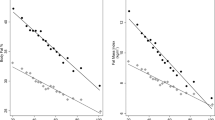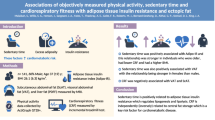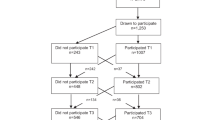Abstract
OBJECTIVE: Increasing physical activity is strongly advocated as a key public health strategy for weight gain prevention. We investigated associations of leisure-time physical activity (LTPA) and occupational/domestic physical activity with body mass index (BMI) and a skinfold-derived index of body fat (sum of six skinfolds), among normal-weight and overweight men and women.
DESIGN: Analyses of cross-sectional self-report and measured anthropometric data.
SUBJECTS: A total of 1302 men and women, aged 18–78 y, who were part of a randomly selected sample and who agreed to participate in a physical health assessment.
MEASUREMENTS: Self-report measures of physical activity, measured height and weight, and a skinfold-derived index of body fatness.
RESULTS: Higher levels of LTPA were positively associated with the likelihood of being in the normal BMI and lower body fat range for women, but few or no associations were found for men. No associations were found between measures of occupational/domestic activity and BMI or body fat for men or women.
CONCLUSION: By using a skinfold sum as a more direct measure of adiposity, this study extends and confirms the previous research that has shown an association between BMI and LTPA. Our results suggest gender differences in the relationship of leisure-time physical activity with body fatness. These findings, in conjunction with a better understanding of the causes of such differences, will have important public health implications for the development and targeting of weight gain prevention strategies.
This is a preview of subscription content, access via your institution
Access options
Subscribe to this journal
Receive 12 print issues and online access
$259.00 per year
only $21.58 per issue
Buy this article
- Purchase on Springer Link
- Instant access to full article PDF
Prices may be subject to local taxes which are calculated during checkout
Similar content being viewed by others
References
Kuzmarski RJ, Flegal KM, Campbell SM, Johnson CL . Increasing prevalence of overweight among US adults: the National Health and Nutrition Examination Surveys 1960 to 1991 JAMA 1994 272: 201–211.
Bennett N, Dodd T, Flatley J, Freeth S, Bolling K . Health Survey for England 1993 HMSO: London 1995.
National Health and Medical Research Council . Acting on Australia's weight: a strategic plan for the prevention of overweight and obesity AGPS: Canberra 1997.
Prentice AM, Jebb SA . Obesity in Britain: gluttony or sloth? Br Med J 1995 311: 437–439.
St Jeor ST, Brunner RL, Harrington ME, Scott BJ, Cutter GR, Brownell KD, Dyer AR, Foreyt JP . Who are the weight maintainers? Obes Res 1995 3: 249s–259s.
DiPietro L . Physical activity, body weight, and adiposity: an epidemiologic perspective Exerc Sport Sci Rev 1995 23: 275–303.
Grilo C . The role of physical activity in weight loss and weight loss management Med Exerc Nutr Health 1995 4: 60–76.
Westerterp KR . Alterations in energy balance with exercise Am J Clin Nutr 1998 68 (Suppl): 970S–974S.
Kromhout D, Saris WH, Horst CH . Energy intake, energy expenditure, and smoking in relation to body fatness: the Zutphen Study Am J Clin Nutr 1988 47: 668–674.
Folsom AR, Caspersen CJ, Taylor HL, Jacobs DR, Luepker RV, Gomez-Marin O, Gillum RF, Blackburn H . Leisure time physical activity and its relationship to coronary risk factors in a population-based sample Am J Epidemiol 1985 121: 570–579.
Williamson DF, Madans J, Anda RF, Kleinman JC, Kahn HS, Byers T . Recreational physical activity and ten-year weight change in a US national cohort Int J Obes Relat Metab Disord 1993 17: 279–286.
Westerterp KR, Goran MI . Relationship between physical activity related energy expenditure and body composition: a gender difference Int J Obes Relat Metab Disord 1997 21: 184–188.
Westerterp KR . Obesity and physical activity Int J Obes Relat Metab Disord 1999 23 (Suppl 1): 59–64.
Westerterp KR . Assessment of physical activity level in relation to obesity: current evidence and research issues Med Sci Sports Exerc 1999 31 (Suppl 11): S522–525.
Salmon J, Owen N, Bauman A, Schmitz MKH, Booth M . Leisure-time, occupational and household physical activity among professional, skilled, and less-skilled workers, and homemakers Prev Med 2000 30: 191–199.
Westerterp KR, Meijer GAL, Kester ADM, Wouters L, Ten Hoor F . Fat-free mass as a function of fat mass and habitual activity level Int J Sports Med 1992 13: 163–166.
Di Pietro I, Williamson DF, Caspersen CJ, Eaker E . The descriptive epidemiology of selected physical activities and body weight among adults trying to lose weight: the Behavioral Risk Factor Surveillance System Survey, 1989 Int J Obes Relat Metab Disord 1993 17: 69–76.
Waters A . Assessment of self reported height and weight and their use in the determination of body mass index Australian Institute of Health and Welfare: Canberra 1997.
Booth ML, Owen N, Bauman A, Gore CJ . Relationship between a 14-day recall measure of leisure-time physical activity and a submaximal test of physical work capacity in a population sample of Australian adults Res Q Exerc Sport 1996 67: 221–227.
Prentice AM, Black AE, Coward WA, Cole TJ . Energy expenditure in overweight and obese adults in affluent societies: an analysis of 319 doubly-labelled water measurements Int J Obes Relat Metab Disord 1996 50: 93–97.
United States Department of Health and Human Services . Physical activity and health: a report of the Surgeon General United States Department of Health and Human Services, Centers for Disease Control and Prevention, National Center for Chronic Disease Prevention and Health Promotion: Atlanta, GA 1996.
National Health and Medical Research Council . Report of the one hundredth session AGPS: Canberra 1985.
World Health Organization . Obesity: Preventing and managing the global epidemic World Health Organization: Geneva 1997.
Booth ML, Owen N, Bauman AE, Gore CJ . Retest reliability of recall measures of leisure-time physical activity in Australian adults Int J Epidemiol 1996 25: 153–159.
Booth M, Bauman A, Owen N, Gore CJ . Physical activity preferences, preferred sources of assistance, and perceived barriers to increased activity among physically-inactive Australians Prev Med 1997 26: 131–137.
Gore CJ, Booth ML, Bauman A, Owen N . Utility of pwc75% as an estimate of aerobic power in epidemiological and population-based studies Med Sci Sports Exerc 1999 31: 348–351.
Perusse L, Tremblay A, LeBlanc C, Bouchard C . Genetic and environmental influences on level of habitual physical activity and exercise participation Am J Epidemiol 1989 129: 1012–1022.
Bouchard C . Heredity and the path to overweight and obesity Med Sci Sports Exerc 1991 23: 285–291.
Withers R, Laforgia J, Heymsfield S, Wang Z, Pillans R . Two, three and four-compartment chemical models of body composition analysis In: K Norton, T Olds (eds). Anthropometrica University of New South Wales Press: Sydney 1996 199–231.
Ryde SJS, Birks JL, Morgan WD, Evans CJ, Dutton J . A five-compartment model of body composition of healthy subjects assessed using in vivo neutron activation analysis Eur J Clin Nutr 1999 47: 863–874.
Norton KI . Anthropometric estimation of body fat In: K Norton, T Olds (eds). Anthropometrica University of New South Wales Press: Sydney 1996 172–198.
Gore CJ . Quality assurance in exercise physiology laboratories In: C Gore (ed). Physiologica tests for elite athletes Human Kinetics: Champaign 2000 3–11.
Melanson EL, Freedson PS . Validity of the computer science and applications, Inc. (CSA) monitor Med Sci Sports Exerc 1995 27: 934–940.
Westerterp KR . Physical activity assessment with accelerometers Int J Obes Relat Metab Disord 1999 23 (Suppl 3): S45–S49.
Author information
Authors and Affiliations
Corresponding author
Rights and permissions
About this article
Cite this article
Ball, K., Owen, N., Salmon, J. et al. Associations of physical activity with body weight and fat in men and women. Int J Obes 25, 914–919 (2001). https://doi.org/10.1038/sj.ijo.0801622
Received:
Revised:
Accepted:
Published:
Issue Date:
DOI: https://doi.org/10.1038/sj.ijo.0801622
Keywords
This article is cited by
-
Fluoride exposure and duration and quality of sleep in a Canadian population-based sample
Environmental Health (2021)
-
Exploring the Effect of Participation in Sports on the Risk of Overweight
Applied Research in Quality of Life (2015)
-
The longitudinal effects of behavioral, health, and socio-demographic factors on body mass index among older Chinese adults
International Journal of Public Health (2012)
-
Occupational Physical Activity and Body Mass Index (BMI) Among Canadian Adults: Does Physical Activity at Work Help to Explain the Socio-economic Patterning of Body Weight?
Canadian Journal of Public Health (2011)
-
Leisure-time physical activity and sedentary behavior clusters and their associations with overweight in middle-aged French adults
International Journal of Obesity (2010)



